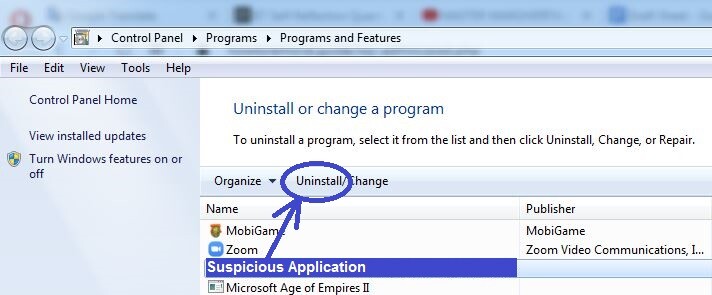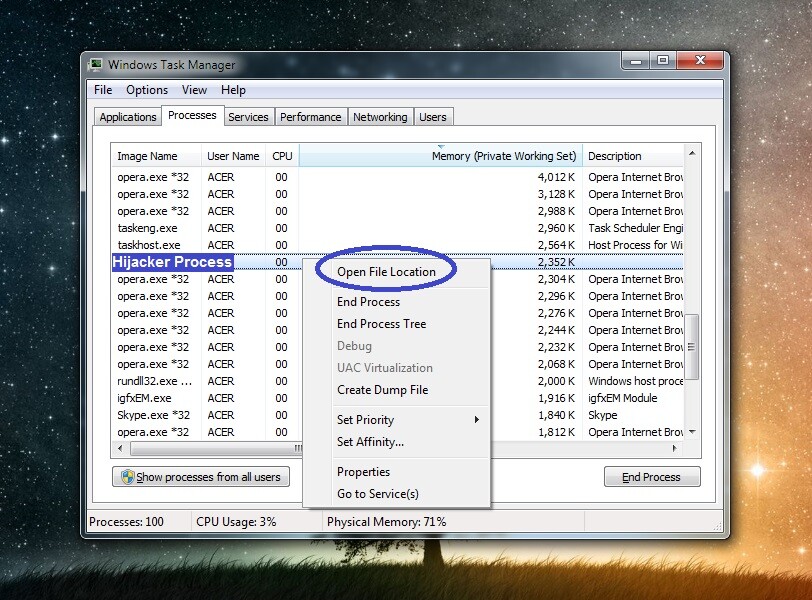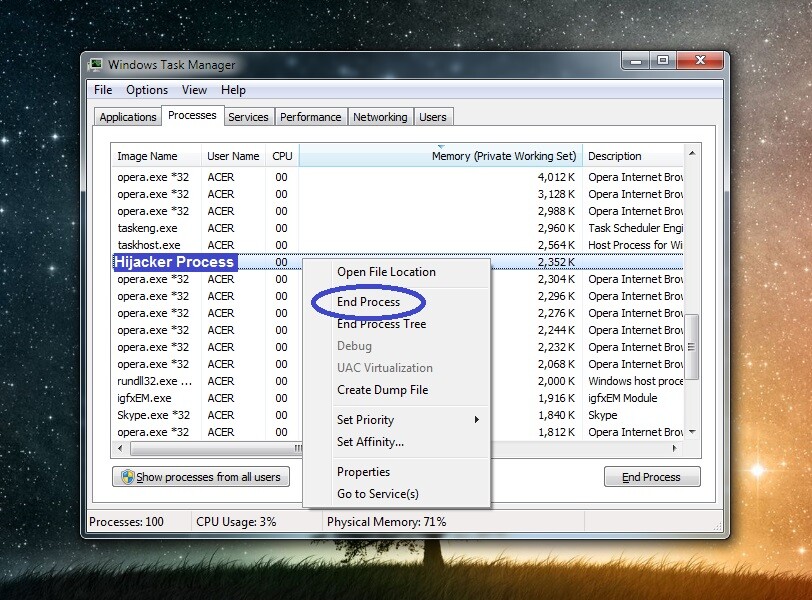
*Tycx is a variant of Stop/DJVU. Source of claim SH can remove it.
Tycx
Tycx is a harmful PC virus that will secretly initiate a data-encryption process in your computer and once that process is finished, your files will no longer be accessible. If you want to remove the Tycx encryption from your files, you will need to use a special private key.

A Ransomware PC virus is a dangerous and harmful piece of software that cyber-criminals use for money extortion and blackmailing. The idea is that the virus blocks the access to the targeted computer or encrypts the files on the PC’s hard-drive and then the hackers use this lockdown as leverage for the following blackmailing. The infection’s victim is informed that they’d have to issue a ransom payment for the removal of the lockdown on their computer or files. The user is threatened that unless the demands of the hackers are met, the locked PC or data would remain that way for good. In the next lines, we will focus on a virus program of the Ransomware category called Tycx that was recently released yet it being a relatively new virus, many customers seem to have already fallen prey to it. This particular malware virus can be categorized as a cryptovirus.
The Tycx virus
The Tycx virus is a problematic and very difficult to detect cyber threat that locks valuable data on the attacked machine to gain blackmailing leverage over its victim. The Tycx virus informs the user about the data lockdown and provides ransom-payment instructions the user is supposed to follow.
The cryptoviruses are known as the nastiest subcategory of Ransomware as it is typically really difficult (and in many cases next to impossible) to successfully deal with the consequences of getting your PC infected by such a virus. The may reason for that comes from the encryption process used by malware programs such as Tycx, Darj and Dapo to lock the user’s data files. The cryptoviruses (unlike the other main Ransomware subcategory known as screen-lockers) do not seek to block the access to the targeted machine. Instead, they target the files on the PC and use a highly-advanced encryption algorithm to render all personal data on the user’s computer inaccessible to anyone who doesn’t have a special access key. As you have probably already guessed, the said key is generated by the virus and held by the hackers after the encryption process has been carried out. It is this key that is the object of the blackmailing scheme. Supposedly, if the user pays the requested money, the key would get sent to them and they’d be able to regain access to their own data files.
Unfortunately, nothing guarantees that the cyber-criminals who are behind the Ransomware infection would actually stay true to their word and provide their victims with the decryption key upon the payment of the ransom. Due to this, we believe that it’s better to seek alternatives and try other options instead of making the payment right away and risking losing your money for a decryption key that might never get sent to you. We might be able to provide you with a possible way out of this mess by giving you a guide for removing Tycx. The guide also includes instructions on file-decryption/file-recovery methods and while we cannot promise you that those restoration methods would always work, it’s still worth the try and will cost you nothing to have a go at them and see what happens.
The Tycx file encryption
The Tycx file encryption is a high-level military-grade encryption algorithm capable of securely locking any piece of data on your computer, thus blocking the access to it. The Tycx file encryption cannot be reversed without a matching private key but there may be ways to bypass it.

One important thing to be noted with regards to the encryption employed by cyber-threats the likes of Tycx is that there are typically no visible symptoms of the virus infection while your data is getting locked. Increased RAM and CPU use might indicate that there’s something not quite right with your system but this potential symptom could be really easy to miss. Another problem concerning the detection of a Ransomware virus is the fact that even antivirus programs oftentimes have difficulties spotting threats like Tycx. The data encryption doesn’t really cause any harm to the system (or to the files that are on it) which is likely the reason why even users with reliable antivirus software on their PC might also fail to intercept the malware on time.
Defense against Ransomware
It is of utmost importance that you make sure to keep your system and data protected against potential future encounters with Tycx or other virus programs similar to it. To make sure that your machine is safe and secure, you ought to keep away from any potential sources of Ransomware infections. Those could be obscure web pages and shady sites, suspicious online content such as malvertising ads, spam e-mail messages that carry questionable attachments, pirated program downloads, illegal torrents and many others. Keep in mind that it is also possible that a Ransomware gets inside your computer with the help of a backdoor virus that has previously infiltrated your system. Trojans Horse infections are very commonly used for the purposes of backdooring Ransomware so make sure that you also have a good antivirus program on your PC in order to fend off potential Trojan attacks. Also, last but not least, be sure to backup all important data that you might not want to lose in case of a Ransomware attack. Save your most valuable files on a separate location (a cloud, an external drive) and make sure that you never connect your PC to that location if you suspect that the computer might have been compromised by Ransomware so that the backup won’t get infected as well.
SUMMARY:
*Tycx is a variant of Stop/DJVU. Source of claim SH can remove it.
Before you start Before you begin the completion of the guide, be sure to familiarize yourself with the next four points and take them into account:
- Ransomware can spread to devices attached to your PC, so be sure to disconnect any flash memory sticks, smartphones, tablets, external drives, or other devices that have their own memory from your PC.
- You should stop your Internet connection while completing the removal process in order to prevent Tycx from communicating with the servers of its creators.
- Paying the ransom is inadvisable, but if you are still considering it, then we recommend delaying the virus removal for after you’e paid it and (hopefully) gotten your data restored. If you delete Tycx before that, you may never be able to get the decryptor key from the hackers.
- A lot of threats of the Ransomware type automatically delete themselves after their job is done. However, even if that seems to be the case on your computer, you should still go through the removal steps to make sure that the threat is no longer in the system.
Remove Tycx Ransomware
To remove Tycx, you must thoroughly clean your PC by completing the following actions:
- Any programs on your computer that have been recently installed and may be linked to the infection must be deleted.
- If there are still Ransomware processes running on the computer, you must identify them and stop them.
- If the virus has made changes to the System Registry, the Hosts file, or the Startup items list, you should restore what has been altered.
- To remove Tycx, you must also not forget to find and delete any rogue files created by the virus on your computer.
To learn how to complete each of those steps, please, follow the instructions shown below.
Detailed Guide

Anything that has been recently installed on your computer that you think may be infectious and responsible for the Ransomware attack must be removed. For this, select the Start Menu, access the Control Panel, and open the Uninstall a Program section. Look on what dates the different programs shown there have been installed and if there is anything sketchy added right before the virus infection, Uninstall it. After you select the Uninstall button and the uninstallation manager shows up, complete whatever steps are in it and if you are offered to keep anything from the program on your computer, refuse the offer.


WARNING! READ CAREFULLY BEFORE PROCEEDING!
*Tycx is a variant of Stop/DJVU. Source of claim SH can remove it.
To search for and quit potentially harmful processes on your system, you need to access the Processes section of the Task Manager – you can open the latter by pressing Ctrl, Shift, and Esc from the keyboard.
If a Ransomware process is still active, it will likely have a strange name and high memory and CPU usage, so look for those red flags and see if you find anything that may be malicious. If you suspect a given process of being linked to the virus, it is important to make sure that it isn’t actually a legitimate system process. One way to do this is to search on the Internet for information about that process – this should typically help you find out if the process is harmful.
Another thing you could do is right-click on the process name, select the File Location option, and scan all files in the folder that opens for malware. There is a powerful and reliable free online scanner below that you can use right now, from this page, without need for installing anything.


Obviously, if there’s malware in the suspected process’ folder, this means you must quit the process in question and then delete its folder with everything that’s in it.


When in Safe Mode, your computer won’t allow non-essential processes to start on their own, and this could help prevent Tycx from interrupting you while you are completing the next steps. Therefore, we recommend booting into Safe Mode.

*Tycx is a variant of Stop/DJVU. Source of claim SH can remove it.
Go to the Start Menu yet again, type in its search bar Folder Options, and go to the first item. In the next window, you must open the View tab and in it find and check the Show hidden files, folders, and drives option, and then select OK.
Now go to the folders shown below by copying their name with the two “%” symbols on either side, placing it in the Start Menu search bar, and hitting Enter.
- %AppData%
- %LocalAppData%
- %ProgramData%
- %WinDir%
- %Temp%
In all of those folders but the last one, you must delete only the data created on the date of the Ransomware infection or after that date. As for the Temp folder, in it, you must select everything by pressing Ctrl + A and then delete it.

Using the Start Menu search bar again, search for “msconfig” and select the file/app shown at the top. In the System Configuration window, open Startup, and if you see any items with unfamiliar names or unknown manufacturers, deselect/uncheck them and then click on OK.
After that, open This Computer, go to the drive that has your OS installed in it (that drive would typically be the C: one), and then go to Windows/System32/drivers/etc. In that folder, you should find and open a file named Hosts – use Notepad to open it.
In the Hosts file, you will see two lines with the word Localhost in them – if anything is written below those lines, copy it and share it in the comments. We will soon reply to your comment and will tell you if the files has been compromised and if anything needs to be deleted from it.


Finally, you must clean the system Registry, but since it holds numerous sensitive settings for your OS and other software, you must be very cautious, so that you don’t end up deleting items that shouldn’t be removed.
You can once again use the Start Menu to search for the Registry Editor – the name of the Editor’s executable is regedit.exe, so type that, and select the app when it shows up. To open it, you will first be asked to provide your Admin approval (you must have Admin privileges), so select Yes.
In the Editor, use the Find button from the Edit menu to evoke the Registry search box, and then use that to find Tycx items and delete them. Make sure that after every deleted item, you perform one additional search to make sure that there aren’t other rogue items left in the Registry.

After there’s nothing left from Tycx, go to these locations in the left panel:
- HKEY_CURRENT_USER > Software
- HKEY_CURRENT_USER > Software > Microsoft > Windows > CurrentVersion > Run
- HKEY_CURRENT_USER > Software > Microsoft > Internet Explorer > Main
If in any of them you see items with strange and seemingly random names that look like this “389ry9wd8u239r898t983t4yr989283d3982r3298r“, remove them from the Registry like you did with the Tycx items.
If the manual steps didn’t help Manually deleting Tycx may not always be an option and in some cases you may need to either contact a professional from your area whom you can your PC to, or use a professional software for dealign with malware threats that can clean your computer from any rogue data. We obviously cannot take a look at your computer, but we can offer you a reliable anti-malware tool that can scan your entire system and clean it from anything malicious that may still be in it. The tool is linked in the guide, and we recommend that you try it out in order to delete the malicious Tycx once and for all.
How to Decrypt Tycx files
To decrypt Tycx files, our team, as well as most other security researchers, recommend using alternative file-restoration methods as opposed to opting for the ransom payment. Before you begin to decrypt Tycx files in this way, the virus must be fully gone from the system.
To ensure there are no rogue files left on your computer, we once again remind you about the powerful free scanner that you can use on our site if you suspect any files in the system of being malicious.
Decryption tool
https://www.emsisoft.com/ransomware-decryption-tools/stop-djvu
Once you are certain that the computer is clean and there’s no longer Ransomware in it, we recommend that you visit the How to Decrypt Ransomware article that we have on this site and use the methods and instructions available in it to try to restore your important data.

Leave a Reply